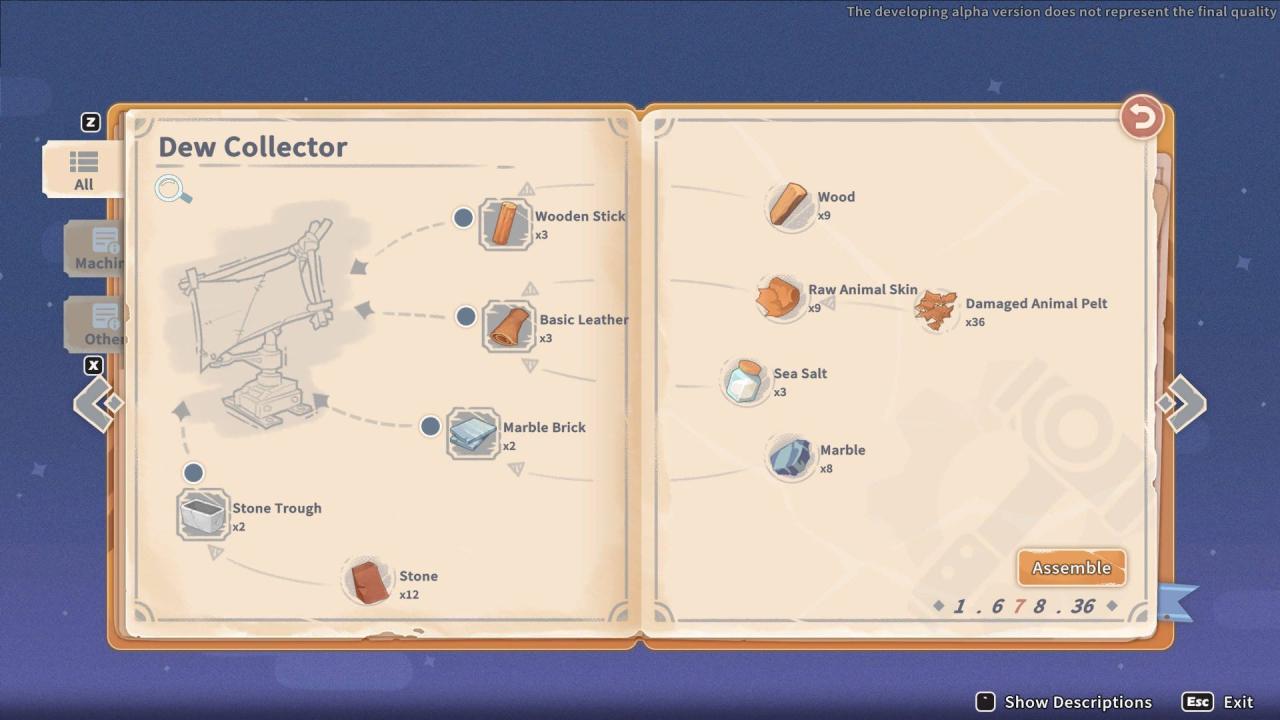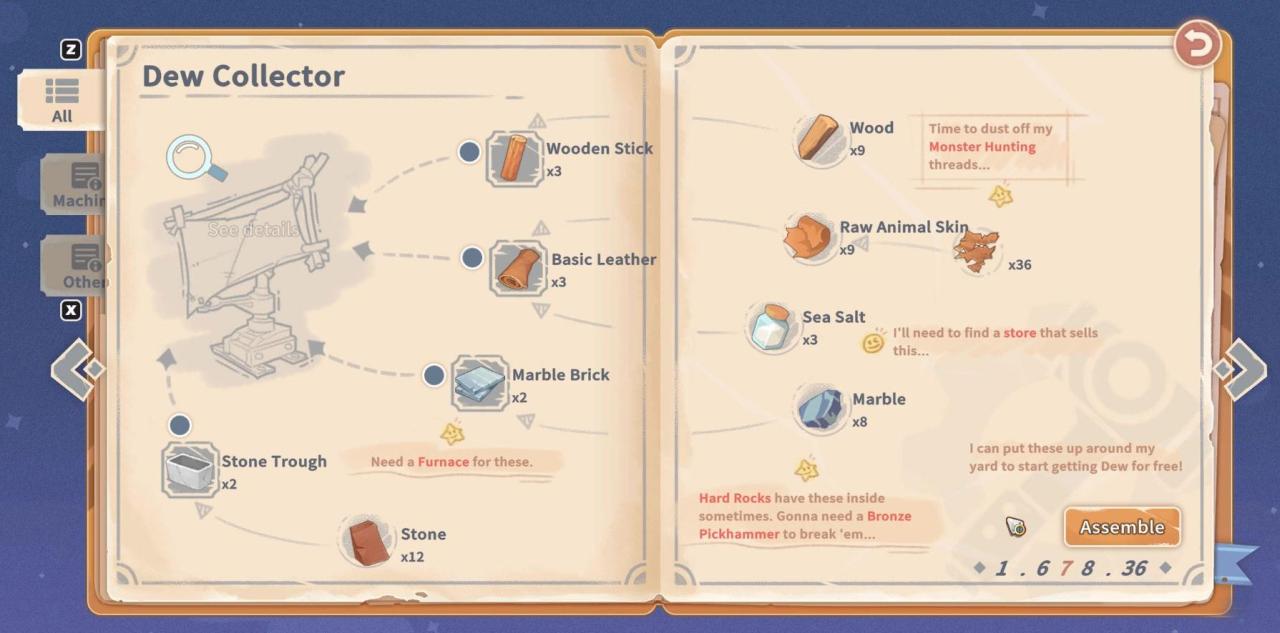My time at sandrock dew collector – My Time at Sandrock: Mastering the Dew Collector takes us on an in-depth exploration of this essential tool, providing a comprehensive guide to its purpose, functionality, and strategic utilization. Join us as we delve into the intricacies of the dew collector, unlocking its potential for reliable water sources and optimizing its performance in various environments.
From crafting and upgrading the dew collector to understanding its strengths and limitations, this guide equips players with the knowledge to maximize their water-gathering capabilities. Whether you’re a seasoned Sandrock veteran or just starting your adventure, this detailed analysis will empower you to harness the power of the dew collector and thrive in the unforgiving world of My Time at Sandrock.
My Time at Sandrock Dew Collector

The Dew Collector in My Time at Sandrock is a valuable tool that allows players to collect water from the air. This water can be used for drinking, cooking, or watering crops. The dew collector is a simple device that is easy to craft and use.
Materials Required
To craft a dew collector, you will need the following materials:
- 10x Stone
- 5x Glass
- 3x Copper Bar
Crafting the Dew Collector
To craft a dew collector, open the crafting menu and select the “Tools” tab. Then, find the “Dew Collector” recipe and click on it. This will open a new window where you can select the materials you want to use.
Once you have selected the materials, click on the “Craft” button to begin crafting the dew collector.
Placing and Using the Dew Collector
Once you have crafted a dew collector, you can place it anywhere on your property. To place the dew collector, simply select it from your inventory and then click on the ground where you want to place it. The dew collector will begin collecting water immediately.
The water will be stored in the dew collector’s tank, which has a capacity of 100 units of water.
To collect water from the dew collector, simply click on it with an empty bucket or bottle. The water will be transferred to the bucket or bottle. You can then use the water for drinking, cooking, or watering crops.
Benefits of Using a Dew Collector

The dew collector is a valuable tool for providing a reliable source of water in arid environments. By condensing water vapor from the air, the dew collector can provide a steady supply of clean water without the need for complex infrastructure or reliance on rainfall.One of the primary advantages of using a dew collector is its low cost and ease of maintenance.
Unlike traditional water sources such as wells or pipelines, which require significant investment and ongoing maintenance, dew collectors are relatively inexpensive to set up and require minimal ongoing care. This makes them a viable option for communities and individuals with limited resources.In addition, dew collectors are not subject to the same seasonal variations as rainfall.
While rainfall can be sporadic and unpredictable, dew formation is a more consistent process that occurs even in arid climates. This means that dew collectors can provide a reliable source of water throughout the year, regardless of the weather conditions.
Maximizing Efficiency
To maximize the efficiency of a dew collector, several factors should be considered:
Location
The dew collector should be placed in an open area with good air circulation to allow for optimal condensation.
Orientation
The collector should be oriented towards the prevailing wind direction to capture the maximum amount of moisture.
Surface area
A larger surface area will allow for more condensation, so choosing a collector with a large surface area is beneficial.
Maintenance
The collector should be cleaned regularly to remove any dirt or debris that may inhibit condensation.
Challenges of Using a Dew Collector
Dew collectors, while offering potential benefits for water harvesting, are not without their challenges and limitations. Understanding these limitations can help users optimize the performance of their dew collectors and mitigate potential issues.One significant challenge in using a dew collector is its dependence on weather conditions.
Dew formation is heavily influenced by factors such as temperature, humidity, and wind speed. During periods of low humidity, high temperatures, or strong winds, dew formation may be minimal or nonexistent, reducing the collector’s water yield.
Crafting and Upgrading the Dew Collector: My Time At Sandrock Dew Collector
Crafting a dew collector requires a crafting table, which can be obtained through various methods in the game. The table serves as a workstation for creating and upgrading the dew collector, as well as other items and structures. To craft the dew collector, players will need the following materials:
- 10x Stone
- 5x Wood
- 3x Iron Ore
Once the materials are gathered, players can interact with the crafting table and select the dew collector recipe from the available options. The crafting process will commence, and upon completion, the player will obtain a basic dew collector.Upgrading the dew collector enhances its performance and efficiency in collecting water.
Each upgrade requires specific materials and resources, and the benefits of upgrading include increased water yield, durability, and resistance to wear and tear. The following table Artikels the materials and benefits associated with each upgrade level:| Upgrade Level | Materials Required | Benefits ||—|—|—|| Level 1 | 5x Stone, 3x Wood, 1x Iron Ore | Increases water yield by 10% || Level 2 | 10x Stone, 5x Wood, 2x Iron Ore | Increases water yield by 15% and durability by 5% || Level 3 | 15x Stone, 7x Wood, 3x Iron Ore | Increases water yield by 20% and durability by 10% || Level 4 | 20x Stone, 9x Wood, 4x Iron Ore | Increases water yield by 25% and durability by 15% || Level 5 | 25x Stone, 11x Wood, 5x Iron Ore | Increases water yield by 30% and durability by 20% |Upgrading the dew collector is crucial for maximizing water collection and ensuring a reliable source of fresh water in the arid environment of Sandrock.
By investing in upgrades, players can significantly improve the efficiency and longevity of their dew collectors, leading to increased water availability and sustainability in their settlements.
Comparison with Other Water Sources
In My Time at Sandrock, the dew collector is one of several water sources available to players. Each water source has its own unique advantages and disadvantages, so it is important to understand the differences before making a decision about which one to use.
The following table compares the dew collector to other water sources in My Time at Sandrock:
| Water Source | Reliability | Efficiency | Cost |
|---|---|---|---|
| Dew Collector | Low | Low | Low |
| Well | High | High | High |
| Water Tower | High | High | High |
| Rain Collector | Low | Medium | Low |
| River | Medium | Medium | Low |
Reliability
The dew collector is the least reliable water source in My Time at Sandrock. It can only collect water at night, and the amount of water it collects depends on the weather. If there is no dew, the dew collector will not produce any water.
Wells and water towers are the most reliable water sources. They can produce water at any time of day or night, regardless of the weather.
Efficiency
The dew collector is also the least efficient water source in My Time at Sandrock. It takes a long time to collect a small amount of water. Wells and water towers are much more efficient, and they can produce a large amount of water in a short amount of time.
Cost
The dew collector is the least expensive water source in My Time at Sandrock. It only requires a few basic materials to build. Wells and water towers are more expensive to build, but they can also produce more water.
Pros and Cons
Here is a summary of the pros and cons of each water source:
Dew Collector
* Pros:Low cost, easy to build
Cons
Low reliability, low efficiency
Well
* Pros:High reliability, high efficiency
Cons
High cost, difficult to build
Water Tower
* Pros:High reliability, high efficiency
Cons
High cost, difficult to build
Rain Collector
* Pros:Low cost, easy to build
Cons
Low reliability, medium efficiency
River
* Pros:Low cost, medium reliability
Cons
Medium efficiency, can be contaminated
Dew Collector in Different Environments
The performance of a dew collector can vary significantly depending on the biome and climate in which it is placed. In general, dew collectors are most effective in areas with high humidity and low wind speeds.
Arid Environments
In arid environments, such as the desert biome in My Time at Sandrock, dew collectors can be a valuable source of water. However, the low humidity levels in these areas mean that dew collectors will produce less water than they would in more humid environments.
To optimize the performance of a dew collector in an arid environment, it is important to place it in a location that receives as much morning sun as possible. This will help to warm the air around the collector and increase the rate of condensation.
- Example:A dew collector placed on the roof of a building in the desert biome can produce up to 1 liter of water per day.
Humid Environments, My time at sandrock dew collector
In humid environments, such as the rainforest biome in My Time at Sandrock, dew collectors can be very effective at producing water. The high humidity levels in these areas mean that dew collectors will produce more water than they would in more arid environments.
To optimize the performance of a dew collector in a humid environment, it is important to place it in a location that is sheltered from the wind. This will help to prevent the wind from blowing away the dew before it can be collected.
- Example:A dew collector placed in a clearing in the rainforest biome can produce up to 2 liters of water per day.
Temperate Environments
In temperate environments, such as the temperate forest biome in My Time at Sandrock, dew collectors can be a useful source of water, but they are not as effective as they are in more humid environments. The moderate humidity levels in these areas mean that dew collectors will produce less water than they would in more humid environments, but more than they would in more arid environments.
To optimize the performance of a dew collector in a temperate environment, it is important to place it in a location that receives as much morning sun as possible and is sheltered from the wind.
- Example:A dew collector placed on the edge of a forest in the temperate forest biome can produce up to 1.5 liters of water per day.
Last Point

In the tapestry of My Time at Sandrock, the dew collector stands as a testament to the ingenuity and adaptability of its inhabitants. Through a thorough examination of its mechanics, challenges, and potential, this guide has illuminated the path to water security and resourcefulness.
Embrace the wisdom imparted here, and may your dew collectors yield an abundance of life-giving water, sustaining your endeavors and shaping your destiny in the vibrant world of Sandrock.
Commonly Asked Questions
Q: What is the primary purpose of the dew collector in My Time at Sandrock?
A: The dew collector serves as a reliable source of water, providing a steady supply for various activities such as hydration, cooking, and crafting.
Q: Are there any prerequisites for crafting the dew collector?
A: Yes, players must have access to a crafting table and gather the necessary materials, including wood, stone, and metal.
Q: How does the dew collector work?
A: The dew collector collects moisture from the air during nighttime, condensing it into water droplets that can be harvested.
Q: What factors can affect the efficiency of the dew collector?
A: Weather conditions, placement, and upgrades can influence the amount of water collected.
Q: How can I upgrade the dew collector?
A: Upgrading the dew collector requires additional resources and materials, but it enhances its water collection capacity and durability.

